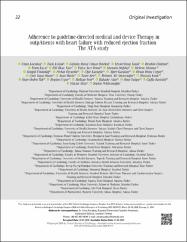Adherence to guideline-directed medical and device Therapy in outpAtients with heart failure with reduced ejection fraction: the ATA study

Göster/
Erişim
info:eu-repo/semantics/openAccessTarih
2020Yazar
Kocabaş, UmutKıvrak, Tarık
Öztekin, Gülsüm Meral Öztekin
Tanık, Veysel Ozan
Özdemir, İbrahim
Tanık, Veysel Ozan
Kaya, Ersin
Yüce, Elif İlkay
Demir, Fulya Avcı
Doğduş, Mustafa
Altınsoy, Meltem
Üstündağ, Songül
Özyurtlu, Ferhat
Karagöz, Uğur
Karakuş, Alper
Urgun, Örsan Deniz
Sinan, Ümit Yaşar
Mutlu, İnan
Şen, Taner
Astarcıoğlu, Mehmet Ali
Kınık, Mustafa
Tok, Özge Özden
Uygur, Begüm
Yeni, Mehtap
Alan, Bahadır
Dalgıç, Onur
Sarıtürk, Çağla
Altay, Hakan
Pehlivanoğlu, Seçkin
Üst veri
Tüm öğe kaydını gösterKünye
Kocabaş, U., Kıvrak, T., Öztekin, GMY., Tanık, VO., Özdemir, I., Kaya, E. (2020). Adherence to guideline-directed medical and device Therapy in outpAtients with heart failure with reduced ejection fraction: the ATA study. The Anatolian Journal of Cardiology, 24(1), 32-40.Özet
Objective: Despite recommendations from heart failure guidelines on the use of pharmacologic and device therapy in patients with heart failure with reduced ejection fraction (HFrEF), important inconsistencies in guideline adherence persist in practice. The aim of this study was to assess ad-herence to guideline-directed medical and device therapy for the treatment of patients with chronic HFrEF (left ventricular ejection fraction ?40%).Methods: The Adherence to guideline-directed medical and device Therapy in outpAtients with HFrEF (ATA) study is a prospective, multicenter, observational study conducted in 24 centers from January 2019 to June 2019.Results: The study included 1462 outpatients (male: 70.1%, mean age: 67±11 years, mean LVEF: 30%±6%) with chronic HFrEF. Renin–angiotensin system (RAS) inhibitors, beta-blockers, mineralocorticoid receptor antagonists (MRAs), and ivabradin were used in 78.2%, 90.2%, 55.4%, and 12.1% of patients, respectively. The proportion of patients receiving target doses of medical treatments was 24.6% for RAS inhibitors, 9.9% for beta-blockers, and 10.5% for MRAs. Among patients who met the criteria for implantable cardioverter–defibrillator (ICD) and cardiac resynchro-nization therapy (CRT), only 16.9% of patients received an ICD (167 of 983) and 34% (95 of 279) of patients underwent CRT (95 of 279).Conclusion: The ATA study shows that most HFrEF outpatients receive RAS inhibitors and beta-blockers but not MRAs or ivabradin when the medical reasons for nonuse, such as drug intolerance or contraindications, are taken into account. In addition, most eligible patients with HFrEF do not receive target doses of pharmacological treatments or guideline-recommended device therapy. (Anatol J Cardiol 2020; 24: 32-40)
Kaynak
The Anatolian Journal of CardiologyCilt
24Sayı
1Bağlantı
https://doi.org/10.14744/AnatolJCardiol.2020.91771https://app.trdizin.gov.tr/makale/TXpZNE1EQTRPQT09
https://hdl.handle.net/11436/5735

















